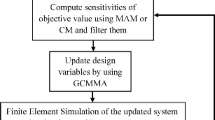Abstract
This work is focused on the topology optimization related to harmonic responses for large-scale problems. A comparative study is made among mode displacement method (MDM), mode acceleration method (MAM) and full method (FM) to highlight their effectiveness. It is found that the MDM results in the unsatisfactory convergence due to the low accuracy of harmonic responses, while MAM and FM have a good accuracy and evidently favor the optimization convergence. Especially, the FM is of superiority in both accuracy and efficiency under the excitation at one specific frequency; MAM is preferable due to its balance between the computing efficiency and accuracy when multiple excitation frequencies are taken into account.

























Similar content being viewed by others
References
Alvin KF (1997) Efficient computation of eigenvector sensitivities for structural dynamics. AIAA J 35:1760–1766
Bendsøe MP, Kikuchi N (1988) Generating optimal topologies in structural design using a homogenization method. Comput Methods Appl Mech Eng 71:197–224
Besselink B et al (2013) A comparison of model reduction techniques from structural dynamics, numerical mathematics and systems and control. J Sound Vib 332:4403–4422
Chen MT, Ali A (1998) An efficient and robust integration technique for applied random vibration analysis. Comput Struct 66:785–798
Cornwell RE, Craig RR, Johnson CP (1983) On the application of the mode-acceleration method to structural engineering problems. Earthq Eng Struct Dyn 11:679–688
Díaz AR, Kikuchi N (1992) Solutions to shape and topology eigenvalue optimization problems using a homogenization method. Int J Numer Methods Eng 35:1487–1502
Dickens JM, Nakagawa JM, Wittbrodt MJ (1997) A critique of mode acceleration and modal truncation augmentation methods for modal response analysis. Comput Struct 62:985–998
Du JB, Olhoff N (2007) Topological design of freely vibrating continuum structures for maximum values of simple and multiple eigenfrequencies and frequency gaps. Struct Multidisc Optim 34:91–110
Grimes RG, Lewis JG, Simon HD (1994) A shifted block lanczos algorithm for solving sparse symmetric generalized eigenproblems. SIAM J Matrix Anal Appl 15:228–272
Gu JM, Ma ZD, Hulbert GM (2000) A new load-dependent Ritz vector method for structural dynamics analyses: quasi-static Ritz vectors. Finite Elem Anal Des 36:261–278
Jensen JS (2007) Topology optimization of dynamics problems with Padé approximants. Int J Numer Methods Eng 72:1605–1630
Jog CS (2002) Topology design of structures subjected to periodic loading. J Sound Vib 253:687–709
Kang Z, Zhang XP, Jiang SG, Cheng GD (2012) On topology optimization of damping layer in shell structures under harmonic excitations. Struct Multidisc Optim 46:51–67
Liu H, Zhang WH, Zhu JH (2013) Structural topology optimization and frequency influence analysis under harmonic force excitations. Chin J Theor Appl Mech 45:588–597
Ma ZD, Kikuchi N, Cheng HC (1995) Topological design for vibrating structures. Comput Methods Appl Mech Eng 121:259–280
Olhoff N, Du JB (2005) Topological design of continuum structures subjected to forced vibration. Proceedings of 6th world congresses of structural and multidisciplinary optimization, Rio de Janeiro, Brazil
Pedersen NL (2000) Maximization of eigenvalues using topology optimization. Struct Multidisc Optim 20:2–11
Shu L, Wang MY, Fang ZD, Ma ZD, Wei P (2011) Level set based structural topology optimization for minimizing frequency response. J Sound Vib 330:5820–5834
Sigmund O, Petersson J (1998) Numerical instabilities in topology optimization: a survey on procedures dealing with checkerboards, mesh-dependencies and local minima. Struct Optim 16:68–75
Stolpe M, Svanberg K (2001) An alternative interpolation scheme for minimum compliance topology optimization. Struct Multidisc Optim 22:116–124
Svanberg K (1995) A globally convergent version of MMA without line search. In: First World Congress of Structural and Multidisciplinary Optimization. Pergamon Press, Goslar, pp 9–16
Tcherniak D (2002) Topology optimization of resonating structures using SIMP method. Int J Numer Methods Eng 54:1605–1622
Wilson EL, Yuan MW, Dickens JM (1982) Dynamic analysis by direct superposition of Ritz vectors. Earthq Eng Struct Dyn 10:813–821
Yoon GH (2010) Structural topology optimization for frequency response problem using model reduction schemes. Comput Methods Appl Mech Eng 199:1744–1763
Yu Y, Jang IG, Kwak BM (2013) Topology optimization for a frequency response and its application to a violin bridge. Struct Multidisc Optim 48:627–636
Zhu JH, Beckers P, Zhang WH (2010) On the multi-component layout design with inertial force. J Comput Appl Math 234:2222–2230
Acknowledgments
This work is supported by the National Natural Science Foundation of China (Grant No. 11432011, 51275424), NSAF (Grant No. U1330124), 973 Program (Grant No. 2011CB610304) and the opening project (KFJJ13-6M) of State Key Laboratory of Explosion Science and Technology (Beijing Institute of Technology).
Author information
Authors and Affiliations
Corresponding author
Rights and permissions
About this article
Cite this article
Liu, H., Zhang, W. & Gao, T. A comparative study of dynamic analysis methods for structural topology optimization under harmonic force excitations. Struct Multidisc Optim 51, 1321–1333 (2015). https://doi.org/10.1007/s00158-014-1218-4
Received:
Revised:
Accepted:
Published:
Issue Date:
DOI: https://doi.org/10.1007/s00158-014-1218-4




